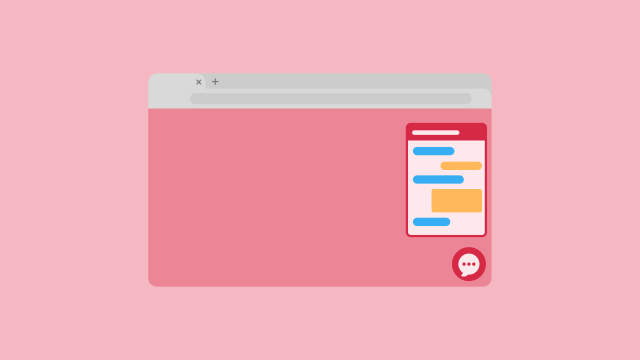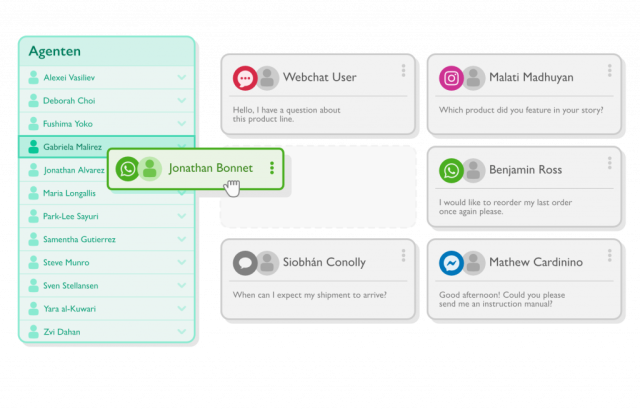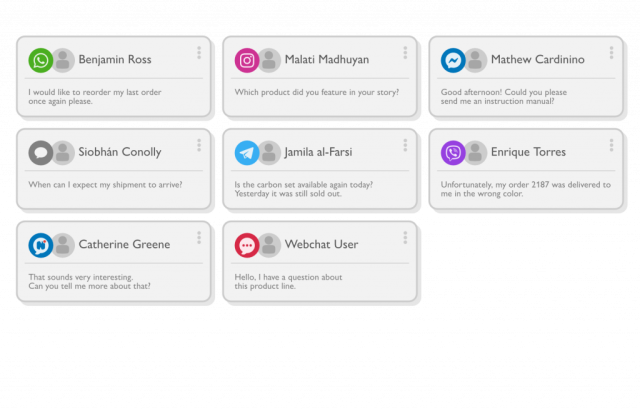Adding a live chat to your website improves your customer service and your customers have a much better experience. As studies show, they prefer a live chat to communicate with companies over e-mail and phone. In this article, we'll give you all facts and insights you need before you start an own live chat service on your website.
Something is wrong with a product you ordered, the delivery didn't arrive on time, or you need one specific piece of information before making a purchase. What would you prefer? Waiting two hours in a call-center queue or two days for an e-mail reply? Or, how about just 46 seconds using live chat? This is the average time it takes companies to answer requests through the channel.
With a customer satisfaction rate of 73%, live chats are already more popular than e-mail and phone for communicating with companies. The number of businesses using live chat tools on their website is growing in B2B and B2C businesses alike.
While customers mainly benefit from quick and easy support with average response times of 46 seconds, businesses save costs, are able to offer a more personal interaction and improve customer experience. As a result, they improve the reputation of their brand.
Learn here how live chats work, what benefits and disadvantages exist, how live chats compare to messaging apps like WhatsApp, Instagram Direct or Telegram and how you can get a live chat for your website free of charge. We'll also show you some really cool examples. Let’s dive in!
What's a live chat?
A live chat is basically an instant messaging service for your website. Through the chat window, that is placed in the bottom right corner on most websites, visitors can ask questions about products, services, or the company itself.
A customer service agent or even a chatbot can answer the customer’s requests via messaging-tool in the background.

However, this also works the other way around. Your company can initiate the chat with visitors to engage them in different ways. This can be done to notify them of certain products or offers, to reassure them of a planned purchase, or just to let them know, that you are there to help.
This way, your company can
- keep visitors on the page
- create a more personal experience
- inform them about what they're interested in
- create engagement with your brand.
💡 Why don’t you start off by asking us some questions with the button in the bottom right corner?
Is a real person behind a live chat?
It depends on what your business requirements are. It's possible to direct all live chats to human agents instantly, but also to let a chatbot take care of the first responses. 85% of page visitors are open to having interactions through chatbots, according to Acquire.
For most companies, a chatbot has a lot of value, as most customer inquiries are recurring questions. That’s a perfect set-up for your chatbot to step in and provide a quick solution. This way, you can free up a lot of human capacities. For complex issues, it is always still possible to hand the request over to a human agent.
How many businesses use live chat?
A lot of businesses started to adapt live chat as a channel for customer communication after the research in recent years displayed the benefits. The live chat software market for example is projected to reach a worth of over a billion dollars by 2023.
The three biggest use cases for live chats are sales, customer support, and marketing. Said benefits for your business are quite similar to messaging apps, although there are some differences. We’ll talk about that later, though.
Let’s first take a look at the numbers. In B2B, 85% of businesses use live chats for sales, 67% for customer support and 54% for marketing. In B2C however, the numbers drop a bit. 74% of businesses use it for sales, 66% for customer support, and only 31% for marketing.

The live chat market is still growing rapidly. It has by far not reached its peak, and latest studies suggest that this channel will grow by 87% in the next twelve to 18 months.
What are live chat benefits? What are disadvantages?
Benefits for your customers
The most striking benefit of a live chat for websites is that people prefer chatting over writing e-mails or talking on the phone. That's one of the main reason why ChatGPT is so popular with users!
In a customer service benchmark study that was conducted by eDigital, results show that live chat has the highest customer satisfaction rate out of all channels with 73%. E-Mail scored 61% and phone only 44%.
One big reason why customers prefer live chats are fast replies. The average response time of live chats is only 46 seconds.
In a survey conducted by Invesp, 79% of the respondents found the immediate replies of live chats to be the most important benefit of the channel. Other points that many found useful were the possibility to multitask while getting support and the efficiency of the communication method.
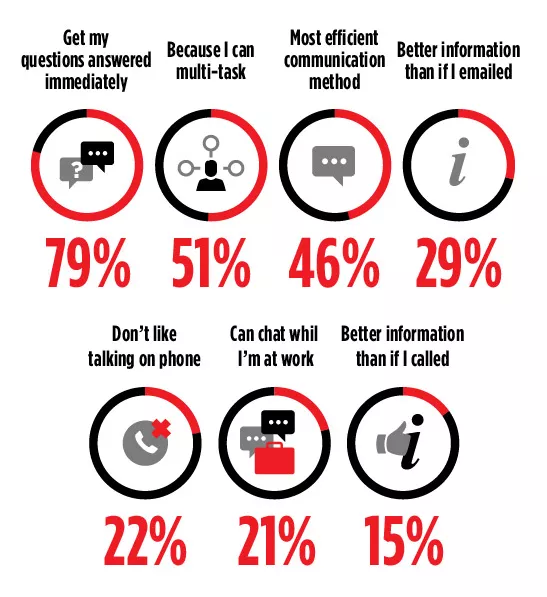
Another important point for using live chats is the supporting function of them while customers shop. The possibility to ask questions is literally right on the page they're visiting and where they're checking out products, so they can get answers instantly while also looking at the products.
But there are not only benefits for the customers. Businesses can also gain a lot from using live chats on their websites.
Benefits for your business
Of course, the first thing that comes to mind, is cost effectiveness. Live chats, just like messaging apps, save up resources like time, employees, and mental capacities. All of these cost your company a lot of money. By using the live chat function, your customer support does not need to be on the phone all the time, can take multiple inquiries at once and quickly solve problems without a long phone conversation or an e-mail back-and-forth.
Additionally, you save the money for setting up a call center (also known as cost centers!), and your staff can use their time for more important tasks.
Live chats are also very good for your company’s reputation. You provide a good first impression for the customers, who feel like they're supported during their customer experience. This, in turn, increases their willingness to buy from you and return to you in the future. Also keep in mind, that a good reputation leads to referrals.
Another great advantage is the personal interaction with your customer to build loyalty. Your company gets more familiar and tangible for your customers when they can talk to you, and good and easy customer service leads them to bond with your brand.
Disadvantages of live chats
There are some disadvantages of live-chat, especially compared to messaging apps like WhatsApp or Facebook Messenger.
- A live chat can not be continued after the conversation ended, as they're anonymous, and the chat history typically isn't saved anywhere. What you can do, though, is direct your customers to your WhatsApp channel via QR-code.
- Offering 24-hour support for live chat isn't possible because of the working hours of your staff.
- There's only one entry point for the customer: your website. For messaging apps, conversations can begin anywhere, like through click-to-chat ads, e-mail newsletters, QR-codes, and so on.
- Live chats don't save customer information for re-activation, marketing and other purposes. Every chat is unique and only limited to a single conversation.
To sum things up, always keep in mind, that live chat can't replace messaging apps for customer communication, but is rather an addition to them. The use case of live chats is a different one than for messaging apps.
Live chats support customers while they're actively gathering information on your website or are in the process of shopping. In that situation, it's a lot more convenient for them to use a chat function on their screen than pull out their mobile phones and continue the process from there. The downside is the above-mentioned disadvantages like the anonymity of the chats and the lacking multi-channel capabilities.
Plus: As more users are starting to shop on mobile devices as well, including a click-to-chat widget for a messaging app is actually a really clever and convenient alternative.

Should I use live chat for my website?
In order to deliver a full-fledged conversational customer experience throughout your whole communication, really try to use all important channels. Don’t think of it as a single additional channel, but as a complete experience that goes on throughout the entire customer journey.
Live chat is a channel that enhances the web experience, whereas other channels, such as messaging apps, create a platform of their own.
You should certainly offer a live chat possibility, as they're not only helpful, but even expected nowadays.
Messaging apps are the next step, and can build on live chats. In some countries, like Brazil or India, companies already use WhatsApp or other messaging apps as the platform for the whole customer journey. Marketing, sales or e-commerce, customer service, and even after-sales activity, they all find a home in messaging services.
Our expert tip is therefore: use both. With tools like Sinch Engage, which was created to unite all conversational activities and channels in one single platform, you offer your customers a non-stop dialogue with your brand.
How can I get a free live chat for my website?
There are different providers for live chat tools on the market. If you're looking for a free and good solution, though, you'll have a hard time finding a provider, that offers a professional tool with good services at no cost.
However, if you use Sinch Engage, you can add a live chat button to your websites. It only takes a few seconds, and there’s no additional cost. Some advantages of Sinch Engage compared to other solutions are:
- A clear and structured interface of the platform allows you to manage all incoming chats from all of your platforms through one central inbox and hand them over to the most suitable agent in your company.
- Unlimited widgets to be implemented on your web pages.
- Easy handover to WhatsApp to keep the conversation going even after the web session is over.
- Chatbot integration: create new chatbots or use existing ones for your live chat and provide a 24/7 live chat service, even on the weekends.
- Easy set-up: Build your own chatbot in minutes, no coding skills required.
- Templates avialable for different industries.
This is how you can use live chat on your website
The live chat functionality is the perfect place for your customers to ask their questions on products, previous orders or even to get inspiration for their next purchase.
As seen in the screenshots below, the live chat works as a kind of virtual assistant, that helps users get things done. This enhances the customer experience a lot.
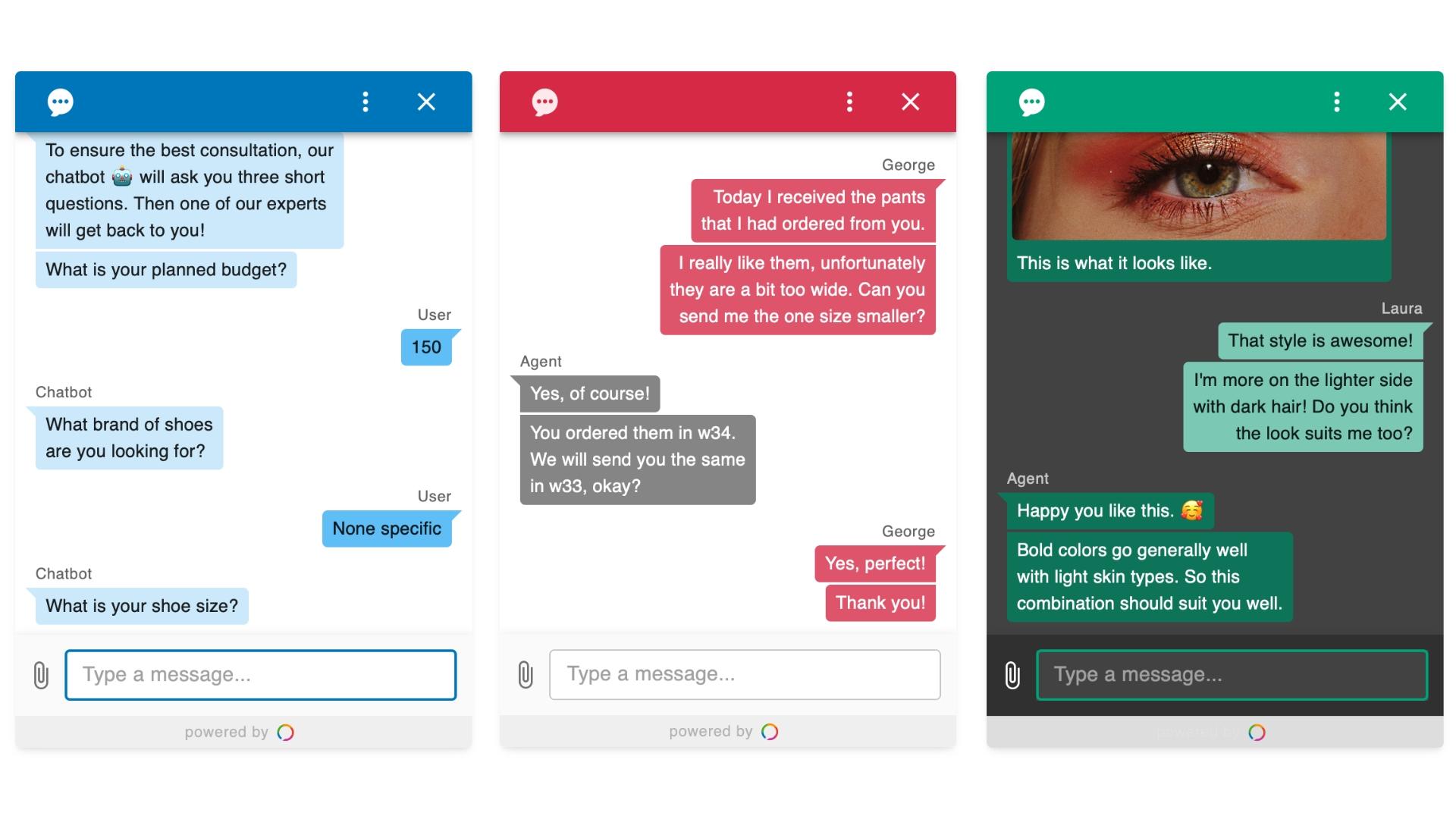
At Sinch Engage, we use the live chat widget, which you can find in the bottom right corner of all our pages.
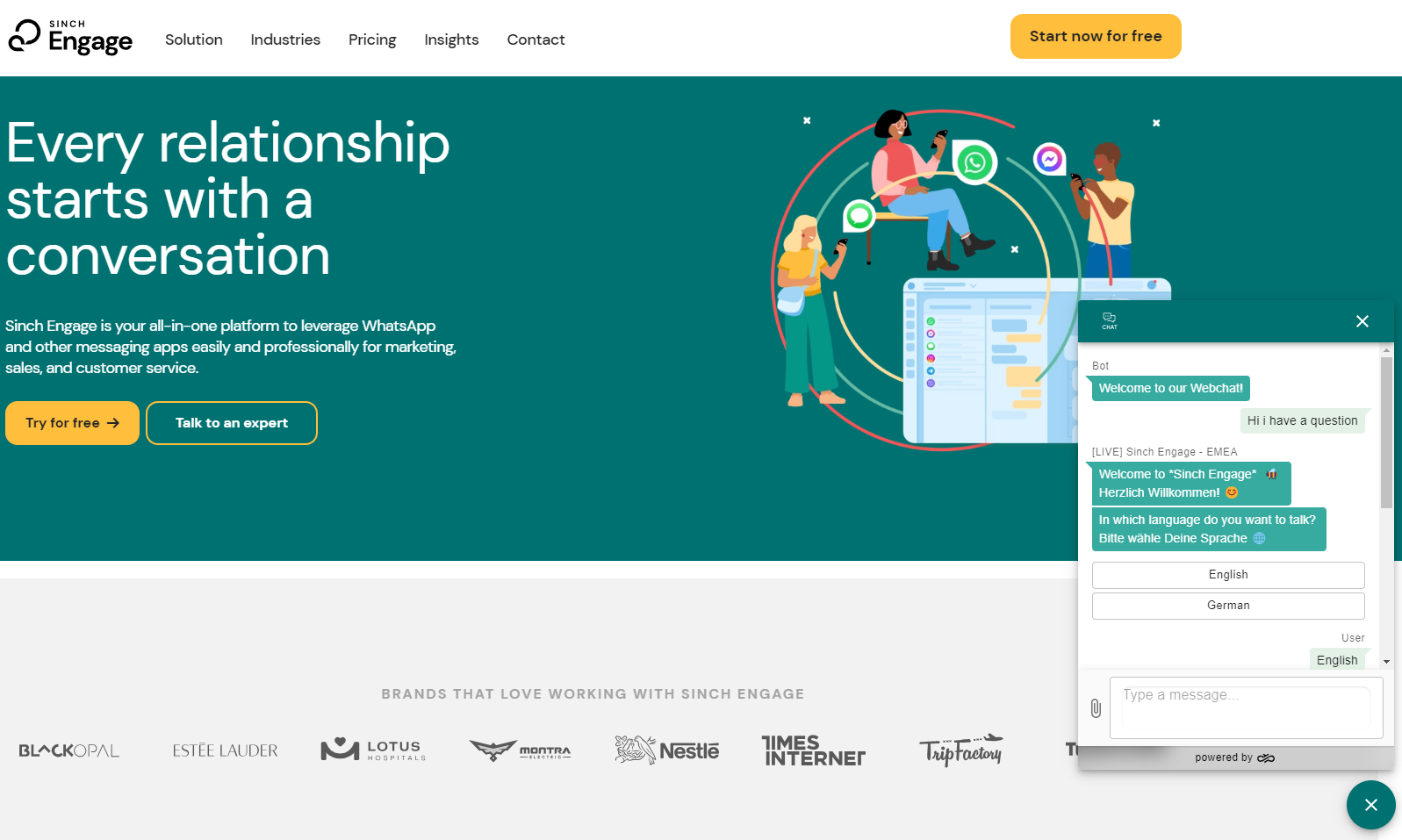
We prefer to use a chatbot for pre-qualification, meaning that the chatbot sorts the different requests based on the answers of the user, to hand them over to the right agent. Using “chat blocks”, this is really easy to implement, and works accurately. The boxes in the chat window provide pre-set answers that users can click on to choose what they are looking for.

Chatbots for live chats
A way to make the experience for your customers even better are AI chatbots. These kinds of chatbots that are powered by Artificial Intelligence have some significant differences to rule-based chatbots. They're
- Able to have free and natural conversations thanks to Natural Language Processing (NLP)
- Available in more than 120 languages
- Improve with every interaction they have and get even more accurate
Speaking of accuracy, it's quite astonishing that these advanced bots are already able to answer customer inquiries with an accuracy rate of over 85 percent! Learn more about this in the free NLP Benchmark study from Sinch Chatlayer
The European Commission’s chatbot for live chat

For their Discover EU initiative that motivates 18-year-old EU citizens to travel Europe, the European Commission built a chatbot together with Sinch Chatlayer, that offers them real-time support via live chat on their website. It answers FAQs and helps them with local differences during their travels.
The chatbot currently handles over 3,000 requests a month, with 80 percent of them being solved fully automated. The chatbot support is available 24 hours a day.
Bizbike’s chatbot for live chat

Bizbike is Belgium’s biggest e-bike provider. To handle the amount of support requests, that a company with 100,000 e-bikes on the road gets, Bizbike was looking for a solution with quick responses that provided high-quality customer support.
They decided to use automated support via chatbots from Sinch Chatlayer as a live chat on their website. Customers of Bizbike can, for example, book a maintenance or repair appointment, schedule a delivery, and set up a test ride for a bike all through the chatbot via live chat.
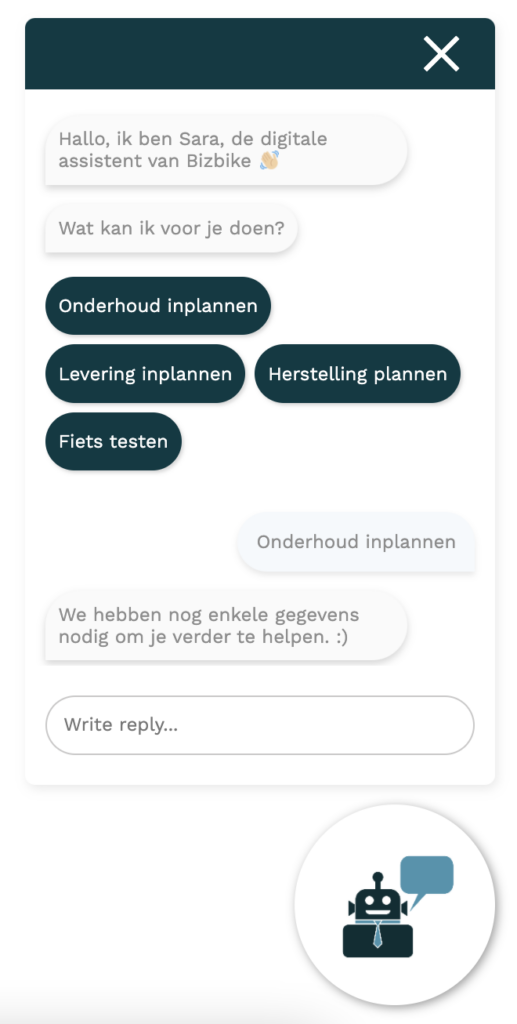
Bizbike’s chatbot made a huge difference for the company! It:
- Manages 30% of the requests without any human support
- Saves more than 40 working hours per month
- Keeps consistent communication with the customers
- Increased Net Promoter Score (NPS) by two Points
